Tungsten Carbide Buttons Wear Resistance Influencing Factors (1/2)
- Details
- Category: Tungsten Information
- Published on Thursday, 10 March 2016 16:52
- Written by xiaobin
- Hits: 235
Take tungsten carbide (WC-Co) as a example, it has high hardness, high density, high strength and excellent chemical stability, but its wear resistance is poor. Related researchers have conducted extensive research, which includes three influencing factors on the wear resistance of tungsten carbide buttons, such as the grain size of solid phase (WC), trace element or additives and chemical heat treatment, etc.
According to the principle that material micro-structure determines the surface property, the researcher propose the granularity of solid phase (WC) in tungsten carbide has a great impact on the wear resistance and they do o lot of extensive researches. The experimental data shows that when the cemented carbide (WC-Co) in the hard phase (WC) grain size is reduced to sub-micron or less, to the material hardness, strength, toughness and wear resistance have been improved to some extent. The relationship of wear rate and WC grain size given as follow:

From the figure we can clearly see in the lower hardness, the hard phase tungsten carbide (WC) hardness plays a major role, while at higher hardness values, the toughness of the material take effects. With the increasing size of the WC particles, accelerated wear, wear rate did rise, but can not be considered biased nano-scale tungsten carbide (WC) particles and wear properties will certainly be advantageous for the wear mechanism and conditions are mutually reinforcing. Generally, the finer the crystal grain size that is smaller defect, the binder phase of cobalt (Co) smaller average freedom, corresponding high hardness and bending strength. With increasing hardness of tungsten carbide, WC grain size and relative sizes of the abrasive is close, no significant correlation between the wear volume losses with the hardness of the alloy.
| Tungsten Carbide Supplier: Chinatungsten Online tungsten-carbide.com.cn | Tel.: 86 592 5129696; Fax: 86 592 5129797;Email:sales@chinatungsten.com |
| Tungsten News&Tungsten Prices, 3G Version: http://3g.chinatungsten.com | Molybdenum News & Molybdenum Price: http://news.molybdenum.com.cn |





 sales@chinatungsten.com
sales@chinatungsten.com